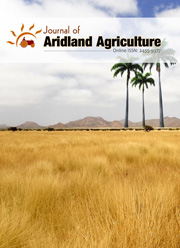Detection of copper ions in arid and semi-arid lands using UV-visible and fluorescence spectrophotometry
DOI:
https://doi.org/10.25081/jaa.2025.v11.9525Keywords:
Semi-arid soil, Rhodanine, Turn-off, Cu2 ions detection, Intensity enhancementAbstract
Generally arid soils are calcareous and prone to contamination of copper due to the usage of high-intensity agriculture and copper-based pesticides which leads to toxicity of organisms present in the soil resulting in fertility loss and crop diseases. We synthesised a sensor R, having a rhodanine scaffold for sensitive and selective detection of Cu2+ ions available in the soil. The sensor exhibited characteristic UV-Visible spectral properties and fluorometric “turn-off” emission properties towards Cu2+ ions. As a practical application detection of Cu2+ ions by the Sensor R adsorbed on a test filter paper system is also reported. The UV–Vis spectrum of sensor R, exhibited an absorption band at 308 nm due to the presence of a thioamide group in the rhodanine moiety and a quantitative intensity enhancement is observed only in presence of Cu2+ ions. In the fluorescence spectra an emission band around 380 nm was observed upon the addition of copper ions and the fluorescence intensity gradually decreased with the increasing Cu2+ concentration indicating the formation of a complex. Nuclear Magnetic Resonance (1H-NMR) analysis indicated that methylene protons signal at δ 4.79 disappeared and shifted up field to appear as a broad peak at δ 3.62. Filter paper strips were dipped into the solution R and dried and subjected to FTIR analysis. On binding with Cu2+ ions the -COOH band appeared with reduced intensity whereas the carbonyl group completely disappeared. The results showed that our method would be suitable to routinely analyse the Cu2+ content in real samples.
Downloads
References
Abd-Alwahab, S. K., Fadeel, Z. G., & Mahmood, S. M. (2020). Determination of Copper and Lead in Soil Samples and Cultivated Plants in Al-Muradiya Area, Iraq. Plant Archives, 20(2), 7461-7464.
Chen, X., Pradhan, T., Wang, F., Kim, J. S., & Yoon, J. (2012). Fluorescent Chemosensors Based on Spiroring-Opening of Xanthenes and Related Derivatives. Chemical Reviews, 112(3), 1910-1956. https://doi.org/10.1021/cr200201z
Cotruvo Jr., J. A., Aron, A. T., Ramos-Torres, K. M., & Chang, C. J. (2015). Synthetic fluorescent probes for studying copper in biological systems, Chemical Society Reviews, 44, 4400-4414. https://doi.org/10.1039/C4CS00346B
Elkhatib, E. A., & Moharem, M. L. (2015). Immobilization of copper, lead, and nickel in two arid soils amended with biosolids: effect of drinking water treatment residuals. Journal of Soils and Sediments, 15, 1937-1946. https://doi.org/10.1007/s11368-015-1127-1
Genova, G., Della Chiesac, S., Mimmoa, T., Borrusoa, L., Cescoa, S., Tasserb, E., Matteazzie, A., & Niedrist, G. (2022). Copper and zinc as a window to past agricultural land-use. Journal of Hazardous Materials, 424, 126631. https://doi.org/10.1016/j.jhazmat.2021.126631
Joshi, D. C. (2016). Adsorption and desorption of copper by calcareous Arid soils. Annals of Arid Zone, 34(4), 253-257.
Jung, H. S. Kwon, P. S., Lee, J. W., Kim, J. I., Hong, C. S., Kim, J. W., Yan, S., Lee, J. Y., Lee, J. H., Joo, T., & Kim, J. S. (2009). Coumarin-Derived Cu2+-Selective Fluorescence Sensor: Synthesis, Mechanisms, and Applications in Living Cells. Journal of the American Chemical Society, 131(5), 2008-2012. https://doi.org/10.1021/ja808611d
Kaur, B., Kaur, N., & Kumar, S. (2018). Colorimetric metal ion sensors – A comprehensive review of the years 2011-2016. Coordination Chemistry Reviews, 358, 13-69. https://doi.org/10.1016/j.ccr.2017.12.002
Li, X., Gao, X., Shi, W., & Ma, H. (2014). Design Strategies for Water-Soluble Small Molecular Chromogenic and Fluorogenic Probes. Chemical Reviews, 114(1), 590-659. https://doi.org/10.1021/cr300508p
Neaman, A., Schoffer, J.-T., Navarro-Villarroel, C., Pelosi, C., Peñaloza, P., Dovletyarova, E., Schneider, J. (2024). Copper contamination in agricultural soils: A review of the effects of climate, soil properties, and prolonged copper pesticide application in vineyards and orchards. Plant, Soil and Environment, 70(7), 407-417. https://doi.org/10.17221/501/2023-PSE
Quang, D. T., & Kim, J. S. (2010). Fluoro- and Chromogenic Chemodosimeters for Heavy Metal Ion Detection in Solution and Biospecimens. Chemical Reviews, 110(10), 6280-6301. https://doi.org/10.1021/cr100154p
Rao, B. S., Patil, D. B., Puli, M. R., & Jayalakshmi, M. (2013). Delineation of copper (cu) and zinc (zn) status in soils of Central Research Station Akola. Journal of Progressive Agriculture, 4(1), 131-134.
Sathyakumar, S., & Sivakumar, K. (2007). Galliformes of India. (Vol. 10). Dehradun, India: Wildlife Institute of India.
Sfrazzetto, G. T., Satriano, C., Tomaselli, G. A., & Rizzarelli, E. (2016). Synthetic fluorescent probes to map metallostasis and intracellular fate of zinc and copper. Coordination Chemistry Reviews, 311, 125-167. https://doi.org/10.1016/j.ccr.2015.11.012
Steinberg, S. M., & Hodge, V. F. (2018). Copper Complexation by Dissolved Organic Matter in arid Soils: A Voltametric Study. Environments, 5(11), 125. https://doi.org/10.3390/environments5110125
Udhayakumari, D., Naha, S., & Velmathi, S. (2017). , Colorimetric and fluorescent chemosensors for Cu2+. A comprehensive review from the years 2013-15. Analytical Methods, 9(4), 552-578. https://doi.org/10.1039/C6AY02416E
Vavoulidou, E., Avramides, E. J., Papadopoulos, P., Dimirkou, A., Charoulis, A., & Konstantinidou-Doltsinis, S. (2005). Copper Content in Agricultural Soils Related to Cropping Systems in Different Regions of Greece. Communications in Soil Science and Plant Analysis, 36(4-6), 759-773. https://doi.org/10.1081/CSS-200043367
Wu, D., Sedgwick, A. C., Gunnlaugsson, T., Akkaya, E. U., Yoon, J., & James, T. D. (2017). Fluorescent chemosensors: the past, present and future. Chemical Society Reviews, 46(23), 7105-7123. https://doi.org/10.1039/C7CS00240H
Published
How to Cite
Issue
Section
Copyright (c) 2025 Zahir Hussain, Dhanus Kumar Bharathamani, Ravi Subban

This work is licensed under a Creative Commons Attribution-NonCommercial 3.0 Unported License.





 .
.